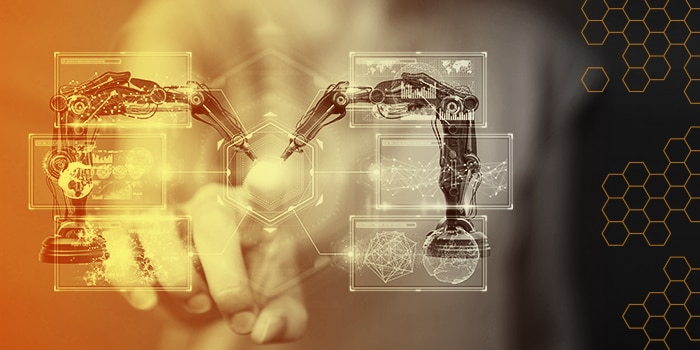In today's service desk environment, a system that can handle requests is an important part of the daily operations of the organization. Providing excellent services manifests positive results, in the eyes of both your internal and external customers. And, there is a new key component that will help ensure your service desk operates successfully: smart technology.
Although quite a broad term,
smart technology features offer numerous benefits to the service desk, integrating many sources to create seamless solutions. With smart technology built into your service desk, you’ll save time and money throughout the service process, allowing your internal service providers to focus their energy on more important tasks.
From artificial intelligence (AI) to automations, smart technology helps you provide a higher standard of future operations within your service desk.
How Does Artificial Intelligence (AI) Learn and Operate?
AI often refers to all the knowledge that is provided by virtual machines, rather than by humans. AI machines are often taught and trained to operate within a specific environment using machine learning, where they continue to adapt and teach themselves other important functions, becoming even more intelligent than before.
There are many
applications of AI in a service desk, one of which includes fraud detection.
AI can be taught to detect patterns, so that when AI recognizes anomalies that may indicate suspicious behavior within a service desk, it can flag it for an internal service provider to resolve. This can help prevent potential legal issues while simultaneously helping to contain dangerous malware, an unexpected benefit of the service desk.
Machine learning is the process through which AI learns how to respond to internal customer requests, which tend to come in the form of tickets. Unlike standard computer programs,
machine learning allows AI to grow and adapt. Whether this is through purely computational learning or taking advice from their human counterparts, machine learning allows AI to constantly grow and develop, becoming more effective over time.
A good example of this is if a problem that frequently affects internal customers requires specific steps to solve it, the machine learning program will realize this correlation and begin to suggest to its AI that it should utilize those steps to solve the case.
Smart Technology Acting as an Internal Service Provider
There are, of course, other examples of AIs within a service desk, like virtual assistants and chatbots. Virtual assistants are experts that provide technical assistance to internal customers. Having virtual assistants take over such tedious tasks allows for your human employees to focus on more productive tasks. Not only does the inclusion of virtual assistants save time by proposing immediate solutions for the service providers to deliver, they also free up personnel to work on more strategic initiatives that benefit the organization.
Smart technology for
human virtual assistants is a bit different, but can be just as beneficial. Queue rooms function as organizational tools for all internal customers who have issued a ticket. Instead of the standard “first come, first served” method, the service desk is able to detect why the person has issued a ticket and organize them into appropriate “rooms,” which are sorted by category.
From there, a service technician capable of handling all problems in that room resolves them by an order of urgency. This saves a lot of time spent rerouting tickets to service providers who can resolve them, as the tickets immediately go to the appropriate service providers.
Virtual chatbots are similar to virtual assistants, as they are also forms of AI that are put on the front lines of the service process in order to help eliminate simpler requests. These bots are programmed to include existing responses and have the ability to improve upon those responses.
Chatbots solve simple issues that don’t require extensive care. For example, these chatbots excel at simple suggestions, such as updating your software. The chatbot can also encourage real-life support through email or phone calls, keeping the support channel functioning. Chatbots help save time and resources by allowing internal service providers to focus on more serious tasks.
Improving Response Times with Automated Processes
If your organization is like most, resources are often stretched to capacity. That means your service providers must prioritize their workload. That’s where automation comes into play.
Automation is the process of reducing the time it takes for a problem to be solved by merging used knowledge to help find a solution. Given that
more than one third of IT professionals spend up to two hours a day on tasks that can be automated, having the option to reduce the number of tedious tasks your internal service providers handle is a game-changer.
Smart technology also knows how to operate in case your internal customers aren’t pleased with the service being provided. Instead of having to dig through an endless amount of comments on tickets in order to find a negative one, a smarter service desk can use sentiment analysis.
Sentiment analysis is a smart feature that is able to detect negative feedback on tickets and flag them. This saves internal service providers time by allowing them to improve upon the service being provided instead of scrolling through feedback.
Like many other smart technology features, sentiment analysis has room to learn and adapt. For example, if it accidentally flags positive feedback, service providers will reject the flagged piece, allowing the sentiment analysis feature to learn from the experience and not flag similar reports. Sentiment analysis can not only save time, but it can actively facilitate improvements to the service the organization provides.
Connecting Resources and Data for Better Service
A helpful technological feature within the service desk is the ability to filter through tickets, instead of having your employees doing manual work. A
configuration management database (CMDB) is a database storing all configuration items (CIs), or things that need to be managed in order to deliver the service. Implementing a
CMDB allows your service desk to behave proactively towards issues, implementing real-time data in order to troubleshoot potential tickets. Not only is a CMDB designed for full visibility of CIs within the organization, it also performs root cause analysis automatically, allowing for faster resolution times.
Another key component of the service desk that enables organizations to more quickly connect employees with the resources they need is a modern service portal. An AI-powered search function within the service portal can suggest solutions similar to Google’s autofill.
Start typing a few words and Google, or in this case the service portal, suggests other frequently-searched phrases. This saves technicians the extensive research behind providing a solution by instead proposing content relevant to the issue at-hand. This type of functionality can also help prevent tickets from being submitted by suggesting relevant knowledge base articles to requesters for self-service.
Integrations serve as another useful method for connecting data and resources to streamline the service experience. Organizations today rely on an array of business technologies, and the service desk is often just one piece of the overall technology puzzle.
A smarter service desk that is capable of integrating with other business critical applications, like Google Apps or Slack, can help to unify these otherwise disconnected sources of organizational data.
Integrating your service desk with a customer relationship management (CRM) platform is one of many examples of the perks of integrations, creating a convenient platform through which your internal service providers can interact with the service desk.
In addition, smart technology in the service desk has not only increased productivity,
it also constantly works to improve upon the service being provided. Technological features that were once built on limited data keep expanding and learning by interacting with internal customers on a daily basis, proving that smart technology is growing and becoming more of an important part of the service desk every single day.
Want to learn more about how your organization could benefit from a smart service desk? Get a free,
customized demo of SolarWinds Service Desk or try it
free for 30 days.





